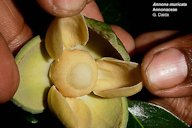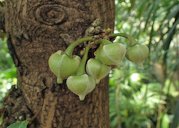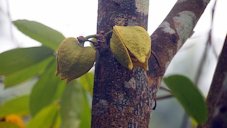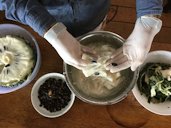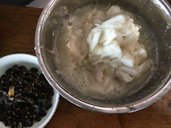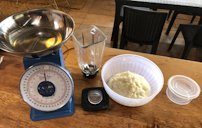| Soursop, Guanábana - Annona muricata | |||||||||||||||||||||||||||||||||||||||||||||
|---|---|---|---|---|---|---|---|---|---|---|---|---|---|---|---|---|---|---|---|---|---|---|---|---|---|---|---|---|---|---|---|---|---|---|---|---|---|---|---|---|---|---|---|---|---|
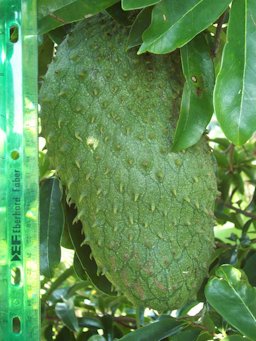 Fig. 1  Annona muricata 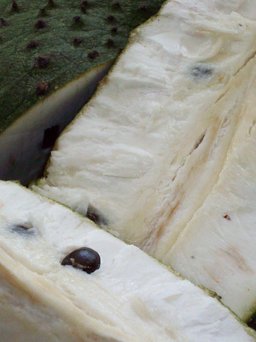 Fig. 2 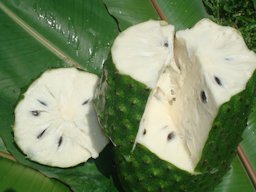 Fig. 3  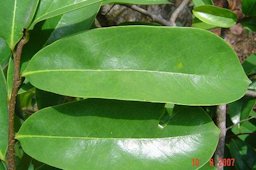 Fig. 4 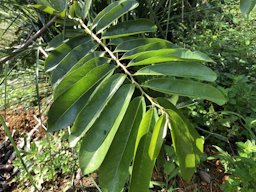 Fig. 5  Leaf habit of the Guanábana, Ecuador 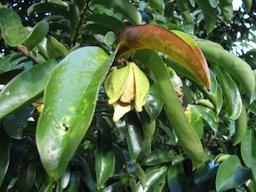 Fig. 8  Flowers and leaves at Pali o Waipio Huelo, Maui 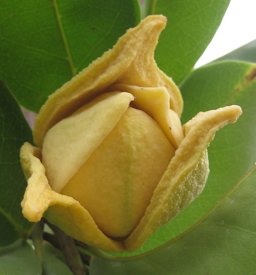 Fig. 9  The flower of soursop (A. muricata), a tropical fruit tree 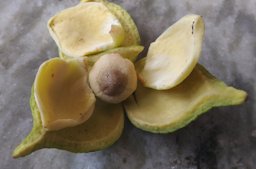 Fig. 10  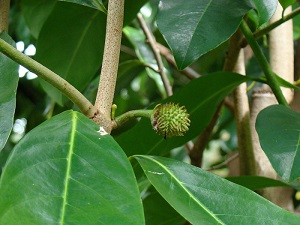 Fig. 14  Fruit forming. Tree is located in Gene Joyner's Unbelievable Acres Botanic Garden, West Palm Beach Florida 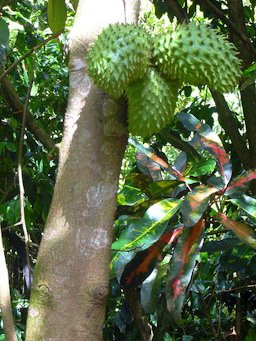 Fig. 15  Fruit growing habit  Fig. 16 Fruit grows on trunk and branches Sukorambi Botanical Gardens, Indonesia 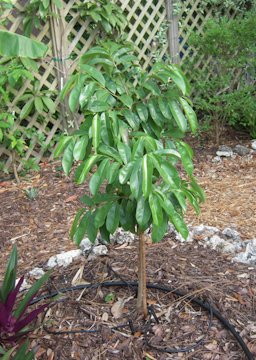 Fig. 20  Newly planted seedling  Fig. 21  A. muricata tree habit 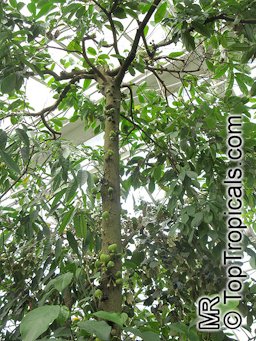 Fig. 22   Fig. 23  A. muricata (soursop), habit at Garden of Eden Keanae, Maui 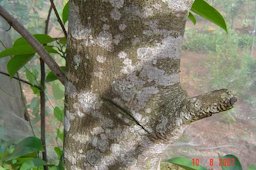 Fig. 24  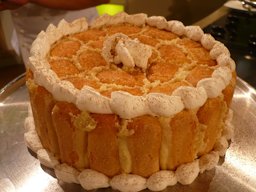 Fig. 25  Corona de Guanábana 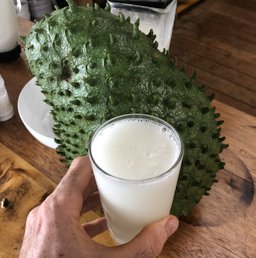 Fig. 26  100% fresh soursop juice  Fig. 34  Harvesting Guanábana in Ecuador 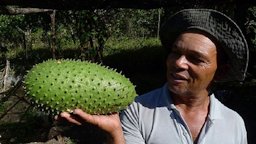 Fig. 35  Bahia, Brazil 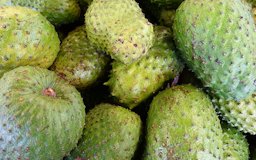 Fig. 36  A. muricata (guanábana) at the market  Fig. 37  Soursop for sale in Bogotá on the corner of Avenida Chile and Carrera 13 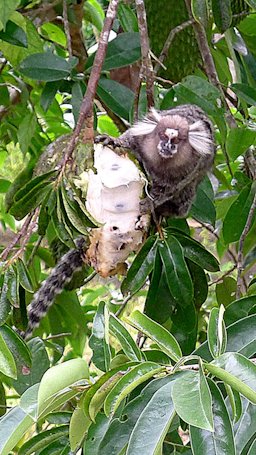 Fig. 38  Feeding on the fruit of A. muricata (soursop). This band of 5 (common marmosets) is a frequent visitor early mornings and also in the afternoon. 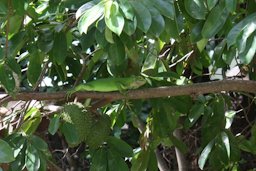 Fig. 39  Lesser Antillean iguana (Iguana delicatissima); juvenile in a soursop tree, Coulibistrie, Dominica |
Scientific
name Annona muricata L. Pronunciation ahn-NOE-nah mur-ee-KAY-tuh Common names English: prickly custard apple, soursop; Spanish: guanábana, guanábano, zopote de viejas, cabeza de negro, catoche, anona de puntitas, anona de broquel; Portuguese: araticum do grande, graviola, coração-de-rainha, jaca-de-pobre, jaca-do-Pará; Netherlands Antilles: sorsaka or zunrzak; Malaya: durian belanda, durian maki; or seri kaya belanda; Thailand: thu-rian-khack; Chamorro: laguaná, laguana, laguanaha, syasyap; Chuukese: saasaf, saasaf, saasap, sasaf; Fijian: sarifa, seremaia; French: anone muriquee, cacheimantier épineux, cachiman épineux, corasol, corossol, corossol, corossol épineux, corossolier; Kosraean: sosap; Maori (Cook Islands): kātara‘apa, kātara‘apa papa‘ā, naponapo taratara; Marquesan: koroso; Marshallese: jojaab; Mokilese: truka shai; Niuean: talapo, talapo fotofoto; Palauan: sausab; Pohnpeian: sae, sei; Samoan: sanalapa, sasalapa, sasalapa; Tahitian: tapotapo papa‘a, tapotapo urupe; Tongan: ‘apele' initia; Tuamotuan: korosor, tapotaporatara; Yapese: sausau 2 Synonyms A. bonplandiana Kunth; A. cearaensis Barb.Rodr.; A. macrocarpa Wercklé; Guanabanus muricatus M.Gómez Family Annonaceae (annona family) Origin West Indies and in northern South America USDA hardiness zones 10b-11 Uses Food Height 15 ft (4.5 m) Spread 15 ft (4.5 m) Plant habit Low branching and bushy, with upturned limbs Growth rate Fast growing Trunk/bark/branches Small, upright slender tree; low branching; bark smooth, dull grey or grey-brown, rough, fissured with age 3 Leaves Evergreen; alternate, smooth, glossy dark green on top, lighter under; have an aroma similar to blackcurrants Flowers Solitary flowers appear on trunk, branches Fruit Oval or heart shaped; lopsided or curved; few inches to over 1 foot in length; may bear fruits anywhere on its trunk or branches Season July to Sept. and Dec. to Feb. USDA Nutrient Content pdf Light requirement Light shade or sun Soil tolerances Tolerant of poor soils; grows best in deep, well-drained, semi dry soil pH preference 5.5-6.5 3,4 Drought tolerance The most drought tolerant of all the annonas Cold tolerance Not tolerant, trees killed by only a few degrees of frost Wind tolerance Not tolerant of strong winds Plant spacing 8-8 ft (2.4-2.4 m) in home gardens; 12-15 ft (3.6-4.5 m) for commercial orchards 1 Roots Shallow, fibrous root system; benefits from copious mulching; juvenile plants have a taproot that is eventually lost 3 Invasive potential * None reported Pest resistance Subject to fruit flies, mealybug and scale insects; anthracnose (Colletotrichum gloeosporioides) Known hazard The juice from the seeds is poisonous and irritating, and should be avoided Reading Material Annona muricata L., Agroforestree Database The Soursop, Manual Of Tropical And Subtropical Fruits Soursop, University of Hawai'i at Mānoa pdf Soursop, Fruits of Warm Climates Origin The soursop originated in the lowlands of Central America. Oviedo, in 1526, described the soursop as abundant in the West Indies and in northern South America. It is today found in Bermuda and the Bahamas, and both wild and cultivated, from sea-level to an altitude of 3,500 ft (1,150 m) throughout the West Indies and from southern Mexico to Peru and Argentina. 1 In Florida, the soursop has been grown to a limited extent for possibly 110 years. Sturtevant noted that it was not included by Atwood among Florida fruits in 1867 but was listed by the American Pomological Society in 1879. A tree fruited at the home of John Fogarty of Manatee before the freeze of 1886. In the southeastern part of the state and especially on the Florida Keys, it is often planted in home gardens. 1
Description Of the 60 or more species of the genus Annona, family Annonaceae, the soursop, A. muricata L., is the most tropical, the largest-fruited, and the only one lending itself well to preserving and processing. 1 A well-known fruit throughout much of the world, the soursop's delicious white pulp, with tones of fruit candy and smooth cream is commonplace in tropical markets, but is rarely found fresh anywhere else. 8 Will not survive outside anywhere in the continental US except in Southern Florida, where it is grown commercially only to a limited extent. Soursop trees require much warmth and humidity, lots of water, and will be killed by temperatures below 32 F/0C. In the tropics, soursops are grown from sea level to 1000m, particularly in humid regions where the tree grows particularly well. Soursop's cannot tolerate standing water, and its roots are shallow, so it does not require a very deep soil base. 8
Leaves The malodorous leaves, normally evergreen, are alternate, smooth, glossy, dark green on the upper surface, lighter beneath; oblong, elliptic or narrow obovate, pointed at both ends, 2 1/2 to 8 in. (6.25-20 cm) long and 1 to 2 1/2 in. (2.5-6.25 cm) wide. 1
Fig. 6. A. muricata (soursop) leaves, KiHana Nursery Kihei, Maui, Hawai'i Flowers The flowers, which are borne singly, may emerge anywhere on the trunk, branches or twigs. They are short stalked, 1 1/2 to 2 in. (4 5 cm) long, plump, and triangular-conical, the 3 fleshy, slightly spreading, outer petals yellow-green, the 3 close-set inner petals pale-yellow. 1 Annona species generally require 27–35 days for flower bud development from initiation to anthesis. Flowering can extend from 3 to 6 months or even longer, with heavy peaks. 7
Fig. 12. A. muricata in Alter Botanischer Garten der Universität Göttingen Pollination High temperatures from 80°F to 90°F and low (30%) relative humidity can cause pollination problems, whereas a lower temperature (in the 70s with 80% relative humidity) improves pollination. 4 The flowers exhibit both dichogomy and a protogynous nature. Soursop floral anthesis takes place mostly between noon and 8 p.m. and 4 a.m.–8 a.m., with pollen release occurring between 4 a.m. and 8 a.m. Flower opening and pollen dehiscence are not synchronous and thus very low self- pollination occurs. Cross-pollination may take place early in the morning because at anthesis the flower usually emits a fragrance that attracts insects. 7 Beetles of several species are important in carrying out natural pollination. Presumably these insects effect cross-pollination, though rather inadequately, for few flowers set fruit and many fruits are misshapen (Fig. 17,18,19) since numerous ovules are not fertilized. 3 In order to increase yield, hand pollination has become an important aspect of cultivation practices in some areas. 7
Fruit Comparisons of its flavor range from strawberry and pineapple mixed together to sour citrus flavour notes contrasting with an underlying creamy roundness of flavour reminiscent of coconut or banana. The fruit is somewhat difficult to eat, as the white interior pulp is studded with many large seeds, and pockets of soft flesh are bounded by fibrous membranes. The soursop is therefore usually juiced rather than eaten directly. The fruit is more or less oval or heart-shaped, some times irregular, lopsided or curved, due to improper carper development or insect injury. The size ranges from 4 to 12 in. (10-30 cm) long and up to 6 in. (15 cm) in width, and the weight may be up to 10 or 15 lbs (4.5-6.8 kg). The fruit is compound and covered with a reticulated, leathery-appearing but tender, inedible, bitter skin from which protrude few or many stubby, or more elongated and curved, soft, pliable "spines". The tips break off easily when the fruit is fully ripe. The skin is dark-green in the immature fruit, becoming slightly yellowish-green before the mature fruit is soft to the touch. Its inner surface is cream-colored and granular and separates easily from the mass of snow-white, fibrous, juicy segments much like flakes of raw fish surrounding the central, soft-pithy core. In aroma, the pulp is somewhat pineapple-like, but its musky, sub acid to acid flavor is unique. Most of the closely-packed segments are seedless. In each fertile segment there is a single oval, smooth, hard, black seed, 1/2 to 3/4 in. (1.25-2 cm) long; and a large fruit may contain from a few dozen to 200 or more seeds. 1 The soursop, unfortunately, is a shy-bearer, the usual crop being 12 to 20 or 24 fruits per tree. 1 Varieties Having no fiber or a reduced amount of fiber in the flesh is the most desired characteristic. Puerto Rico cataloged 14 types. Popular cultivars include ‘Morada’ (Brazil), ‘Cuban Fibreless’ (Australia), ‘Sirsak Ratu’ (Java), and ‘Bennett’, a blue-green skinned type introduced to Florida in 1920. Season The soursop tends to flower and fruit more or less continuously. 1 Soursops bear two main crops a year in South Florida. Spring blooming results in ripe fruit in July, August and September. Summer blooming results in ripe fruit in December, January and February. 11 Harvesting The unripe dark green fruit is covered with an inedible skin with soft spines. Harvest takes place when the color lightens and changes to a slightly yellowish-green. The spines soften and the fruit appears bloated, with segment margins becoming smooth and less noticeable. Generally it takes 4 or 5 days for the fruit to fully ripen after picking, when the skin yields to slight pressure. 4 Studies of the ripening process in Hawai'i have determined that the optimum stage for eating is 5 to 6 days after harvest, at the peak of ethylene production. 1 Propagation Although usually propagated by seed, better fibreless varieties can be grafted. Air layering is possible, but the success rate is considered marginal. If planted within 30 days of harvest, 90 percent of the seeds are viable and germinate in 15-30 days. Some seeds will stay viable up to 6 months. Seeds should be washed before planting. 4 Soursop seedlings are generally the best stock for propagation, though grafting onto custard apple (Annona reticulata), the mountain soursop (A. montana), or pond apple (A. glabra), is usually successful. The pond apple has a dwarfing effect. 1
Grafting Annonas in Southern Florida, Hort Science pdf Culture Mulching is recommended to avoid dehydration of the shallow, fibrous root system during dry, hot weather. If in too dry a situation, the tree will cast off all of its old leaves before new ones appear. 1 The soursop is truly tropical. Young trees in exposed places in southem Florida are killed by only a few degrees of frost. The trees that survive to fruiting age on the mainland are in protected situations, close to the south side of a house and sometimes near a source of heat. Even so, there will be temporary defoliation and interruption of fruiting when the temperature drops to near freezing. 1 Mr. Hahdeem: The tree will defoliate with temperature of 44-45 °F if the conditions are windy. Should this happen four or five times, the tree will die of exaustion due to a diminished reserve of glucose. Pruning Once shaped, the tree requires little pruning other than cutting out dead or poorly placed branches. This should be done after harvest. Trees can be topped at about 6 feet, causing fruit production on lateral branches to facilitate harvesting. 4 Fertilizing Excellent results have been obtained in Hawai'i with quarterly applications of 10-10-10 N P K—1/2 lb (.225 kg) per tree the first year, 1 lb (.45 kg)/tree the 2nd year, 3 lbs (1.36 kg)/tree the 3rd year and thereafter. 1 Pests Page Food Uses Soursops of least acid flavor and least fibrous consistency are cut in sections and the flesh eaten with a spoon. The seeded pulp may be torn or cut into bits and added to fruit cups or salads, or chilled and served as dessert with sugar and a little milk or cream. To make soursop juice: Peel the soursop fruit removing the green skin. Mix 50% ripe white soursop flesh without the seeds with 50% water. Blend the white soursop flesh for about 30 seconds. Tool of choice would be a blender. Don’t strain the white soursop flesh (you would miss the health fiber). Also no need add any flavoring ingredients or use ice. If you want the juice to be cold keep it in the fridge for a while. 6 Bottled and canned soursop beverages are popular in south-east Asia and are much sought after as health drinks. 9 Immature soursops are cooked as vegetables or used in soup in Indonesia. They are roasted or fried in northeastern Brazil. I have boiled the half-grown fruit whole, without peeling. In an hour, the fruit is tender, its flesh off-white and mealy, with the aroma and flavor of roasted ears of green corn (maize). 1
Fig. 27,28,29,30. Processing the soursop Fig. 31. Guyabano wine Fig. 32. Mousse de corossol servie dans un restaurant à Guadalupe, au nord de l'île de São Tomé (São Tomé et Principe) Fig. 33. Champola de Guanabana
Ulu Bread Pig in a Blanket, Hawai'i Tropical Fruit Growers pdf Commercial Uses Enriched pulp, sweetened or unsweetened, can be processed and stored frozen for use in various products or reconstituted directly by the consumer. Purée and juice concentrates can be used to prepare iced soursop drink or mixed with other juices, or made into sherbets and gelatin dishes. The juice, with the addition of sugar, makes an excellent ice cream or sherbet for making a refreshing drink. ‘Champola’ (Fig. 33) made with strained pulp, milk and sugar is a famous fruit drink in Havana, Cuba. In the Dutch East Indies, the juice mixed with wine or brandy is a popular drink. The fruit also makes excellent preserve, jam or jelly. In Malaysia, the delicate flavour of soursop is popular for flavouring ice cream and puddings. In the Philippines, young soursop fruit with seeds that are still soft may be used as a vegetable and cooked with coconut milk. Mature but hard fruit may be made into sweets. 7 In Indonesia a sweet cake (dodol sirsak) is made by boiling thurian-thet pulp in water and adding sugar until the mixture hardens. 10 Some Key West restaurants have always served soursop ice cream and now the influx of residents from the Caribbean and Latin American countries has created a strong demand for it. The canned pulp is imported from Central America and Puerto Rico and used in making ice cream and sherbet commercially. 1 Nutritional Properties The edible portion of the soursop fruit is an excellent source of vitamins B and C, and a fair to poor source of calcium and phosphorus. Soursop is a good source of potassium, riboflavin and niacin. 7 Medicinal Properties ** Sour sop is often used in traditional medicine. Research has shown that it is antimalarial, uterine stimulant, anticrustacean, antiparasitic, cytotoxic (acetogenins), cardiac depressant, antiamoebic, antibacterial, antifungal, hypertensive, spasmogenic, vasodilator, insecticide, smooth muscle relaxant. 5 Note from Mr. Mahdeem: Only certain soursop trees contain high content of the alkaloids used for herbal medical remedies. You should have the leaves analyzed to ascertain their chemical content before using them for tea. Other Uses When pulverized, the seeds are effective pesticides against head lice, southern army worms and pea aphids, petroleum ether and chloroform extracts are toxic to black carpet beetle larvae. The seed oil kills head lice. The leaf decoction is lethal to head lice and bedbugs. The bark of the tree has been used in tanning. The bark fiber is strong but, since fruiting trees are not expendable, is resorted to only in necessity. Bark, as well as seeds and roots, has been used as fish poison. 1 General The name soursop is derived from the Dutch zuurzak meaning sour sack. 4 Note: The juice from the seeds are poisonous and irritating and should be avoided. Research carried out in the Caribbean has established a connection between consumption of soursop and atypical forms of Parkinson's disease due to the very high concentration of Annonacin. 1 In Florida, Santol has this to say about the soursop. "Everybody loves a good soursop... Many varieties are quite fibrous, but that is not a major concern because the juice is used much more than the pulp. Still, it's good to have a fiberless variety. The two best fiber-less cultivars are 'Cuban Fiberless' and 'Fuerth'. Both are usually available from fruit tree nurseries. Two other cultivars are 'Seedless' and 'Sweet'. The names speak for themselves, but I would advise tasting the fruit prior to buying the tree, especially the seedless. Seedless varieties of any fruit are often quite insipid."
Other Edilbes in the Annona genus Atemoya (A. squamosa x A. cherimola) Biriba (Rollinia mucosa, A. mucosa) Cherimoya (A. cherimola) Custard Apple (A. reticulata) Ilama (A. macroprophyllata) Mountain Soursop (A. montana) Pond Apple (A. glabra) Poshte (A. scleroderma) Sugar apple (A. squamosa) Further Reading Custard Apples, Annona spp., Neglected Crops Annona muricata, PROSEA Soursop Botanical Art List of Growers and Vendors |
||||||||||||||||||||||||||||||||||||||||||||
| Bibliography 1 Fruits of Warm Climates. Julia F. Morton, Miami, 1987. 2 "Annona muriticata." National Tropical Botanical Garden, ntbg.org. Accessed 12 Mar. 2015. 3 "Annona muriticata." Agroforestry Net, agroforestry.net. Accessed 13 Mar. 2015. 4 Love, Ken, et al. "Soursop." Hawai'i Tropical Fruit Growers, CTAHR Dept. of Tropical Plant and Soil Sciences, 2011, ctahr.hawaii.edu. Accessed 14 Mar. 2015. 5 Medicinal Plants in the South Pacific. World Health Organization, Manilla, 1998. 6 "The Soursop Juice." PermaTree, 6 Apr. 2019, (CC BY-NC 3.0), www.permatree.org/ecuador/soursop-uses-and-recipes/. Accessed 11 Aug. 2021. 7 The Encyclopedia of Fruit & Nuts. Edited by Jules Janick and Robert E. Paull, Cambridge, CABI, 2008. 8 "Sousop, Annona muriticata." Trade Winds Fruit, www.tradewindsfruit.com/content/soursop.htm. Accessed 12 Aug. 2021. 9 Lim, T. K. "Edible medicinal and non-medicinal plants, Fruits, vol. 1." ZLibrary, 2012, 1lib.us/book/1310933/1bdc97. Accessed 12 Aug. 2021. 10 Subhadrabandhu, Suranant. "Thurian-thet (Annona muricata L.)." Under-utilized Tropical Fruits of Thailand, Rap pub. 2001/26, Food And Agriculture Organization of the United Nations, Dec. 2001, FAO, www.fao.org/3/ab777e/ab777e00.htm. Accessed 12 Aug. 2021. 11 Popenoe, John. "Status of Annona Culture in South Florida." Florida State Horticultural Society, 2014, journals.flvc.org/fshs/article/view/98517/94503. Accessed 24 Dec. 2024. Videos v1 "Annonas with Har, Introduction." Truly Tropical Farms, 6 Jan. 2021, (CC0), www.youtube.com/watch?v=V-0JiXT7s5s. Accessed 7 Aug. 2021 v2 "Annonas with Har, Soursop (Annona muriticata)." Truly Tropical, 22 Apr. 2021, (CC0), www.youtube.com/watch?v=sdLGbUMOOiw. Accessed 11 Aug. 2021. v3 "Hand Pollinating Annonas with Har." Truly Tropical, 29 May 2019, (CC0), www.youtube.com/watch?v=sB9Mhjq9UZc. Accessed 6 Aug. 2021. v4 "How to Graft Annona Fruit Trees Using Cleft Graft - Grafting Dream Cherimoya, Atemoya, etc." Sulcata Grove, 26 Feb. 2017, www.youtube.com/watch?v=1_Xy-rZQmdg. Accessed 23 July 2021. v5 "Soursop full process: From harvest to pulp." Permatree, 18 Aug. 2019, (CC BY-NC 3.0), www.permatree.org/es/ecuador/soursop-full-process-from-harvest-to-pulp/. Accessed 11 Aug. 2021. Photographs Fig. 1,2,21 Bronson, Eric. "Annona muriticata, soursop." I likE plants! 15 June 2009, (CC BY-NC-ND 3.0 US), ilikerareplants.blogspot.com/2008/08/annona-muricata-soursop.html. Accessed 11 Aug. 2021. Fig. 3 "La guanábana." Huellas Blog, 16 Dec. 2021, (CC BY-NC 3.0), nix-huellas.blogspot.com/2012/12/resumiendo.html. Accessed 11 Aug. 2021. Fig. 4,7,24 Kwan. "Annona muricata." The Plant Observatory, 2007, natureloveyou.sg. Accessed 29 Aug. 2014. Fig. 5,26,27,28,29,30,34 "Soursop full process: From harvest to pulp." Permatree, 18 Aug. 2019, (CC BY-NC 3.0), www.permatree.org/es/ecuador/soursop-full-process-from-harvest-to-pulp/. Accessed 11 Aug. 2021. Fig. 6 Starr, Forest, and Kim. "Annona muricata (soursop) leaves, KiHana Nursery Kihei, Maui, Hawai'i." Starr Environmental, no. 110215-1210, 15 Feb. 2011, (CC BY 4.0), starrenvironmental.com. Accessed 29 Aug. 2014. Fig. 8 Starr, Forest, and Kim. "Annona muricata (soursop) flowers and leaves at Pali o Waipio Huelo, Maui." Starr Environmental, no. 121108-0855, 8 Nov. 2012, (CC BY 4.0), starrenvironmental.com. Accessed 29 Aug. 2014. Fig. 9 Rulkens, Ton. "The flower of soursop (Annona muricata), a tropical fruit tree." Wikimedia Commons, 2010, (CC BY-SA 2.0), commons.wikimedia.org. Accessed 13 Jan. 2016. Fig. 10 Vijayanrajapuram. "Annona muricata, soursop flower." Wikimedia Commons, 12 Sept. 2017, (CC BY-SA 4.0), commons.wikimedia.org//wiki/File:Annona_muricata_soursop_flower_10.jpg. Accessed 11 Aug. 2021. Fig. 11 Daida, G. "Annona muricata." University of Hawaii Botany Dept., Mānoa Campus Plants, botany.hawaii.edu. Accessed 29 Aug. 2014. Fig. 12 Kenraiz, Krzysztof Ziarnek. "Annona muricata in Alter Botanischer Garten der Universität Göttingen." Wikimedia Commons, 5 June 2019, (CC BY-SA 4.0), commons.wikimedia.org/wiki/File:Annona_muricata_kz01.jpg. Accessed 11 Aug. 2021. Fig. 13 Tu7uh. "Soursop Bud." Wikimedia Commons 2013, (CC BY-SA 3.0), commons.wikimedia.org. Accessed 13 Jan. 2016. Fig. 14 Thaumaturgist, Ghosh, Asit K. "Tree is located in Gene Joyner's Unbelievable Acres Botanic Garden. West Palm Beach Florida." Wikimedia Commons, 2008, commons.wikimedia.org. Accessed 13 Mar. 2015. Fig. 15 Lytle, David. "Fruit on their tree." Wikipedia, wikepedia.org. Accessed 29 Aug. 2014. Fig. 16 Crisco 1492. "Sorsal. Sukorambi Botanical Gardens." Wikimedia Commons, 2014, commons.wikimedia.org. Accessed 13 Mar. 2015. Fig. 17 Clark, Dan. "Soursop, Annona muriticata." USDI National Park Service, 2007, Bugwood, bugwood.org. Accessed 12 Mar. 2015. Fig. 18 "Annona muricata." Top Tropicals, toptropicals.com. Accessed 29 Aug. 2014. Fig. 19 Costa PPPR. "Annona muricata (graviola), fruto." Wikimedia Commons, 2014, commons.wikimedia.org. Accessed 13 Mar. 2015. Fig. 20 Robitaille, Liette. "Annona muritica Series." 2014, www.growables.org. Fig. 22 MR. "Annona muricata." Top Tropicals, toptropicals.com. Accessed 29 Aug. 2014. Fig. 23 Starr, Forest, and Kim. "Annona muricata (soursop), habit at Garden of Eden Keanae, Maui." Starr Environmental, no. 110330-3833, 30 Mar. 2011, (CC BY 4.0), starrenvironmental.com. Accessed 29 Aug. 2014. Fig. 25 López, María Eugenia. "Corona de Guanábana." El Gourmet Urbano, (CC BY-NC 3.0), elgourmeturbano.blogspot.com/2013/03/corona-de-guanabana-por-maria-eugenia.html. Accessed 11 Aug. 2021. Fig. 31 Ringer. "Guyabano wine." Wikimedia Commons, 14 Mar. 2015, (CC BY-SA 4.0), commons.wikimedia.org/wiki/File:Guyabano_wine.jpg. Accessed 11 Aug. 2021. Fig. 32 Ji-Elle. "Mousse de corossol servie dans un restaurant à Guadalupe, au nord de l'île de São Tomé (São Tomé et Principe)." Wikimedia Commons, 27 Jan. 2019, (CC BY-SA 4.0), commons.wikimedia.org/wiki/File:Mousse_de_corossol_(São_Tomé).jpg. Accessed 11 Aug. 2021. Fig. 33,34 "Champola de Guanabana." My Cuban Traumas, 3 Oct. 2008, (CC BY-NC-ND 3.0 US), mycubantraumas.blogspot.com/2008/10/champola-de-guanabana.html. Accessed 12 Aug. 2021. Fig. 35 Popovkin, Alex. "Annona muricata L. Bahia, Brazil." Wikimedia Commons, 2014, (CC BY 2.0), commons.wikimedia.org. Accessed 13 Mar. 2015. Fig. 36 Daderot. "Annona muricata (guanábana) at the market." Wikimedia Commons, 16 Mar. 2017, (CC0), commons.wikimedia.org/wiki/File:Annona_muricata_(guanábana)_-_DSC09277.jpg. Accessed 11 Aug. 2021. Fig. 37 Angritt, Peter. "Soursop for sale in Bogotá on the corner of Avenida Chile and Carrera 13." Wikimedia Commons, 9 July 2012, (CC BY-SA 4.0), commons.wikimedia.org/wiki/File:Guanábana_en_Bogotá.JPG. Accessed 11 Aug. 2021. Fig. 38 Popovkin, Alex. "Feeding on the fruit of Annona muricata (soursop). This band of 5 (common marmosets) are a frequent visitor early mornings and also in the afternoon. Bahia, Brazil." Wikimedia Commons, 2012, (CC BY 2.0), commons.wikimedia.org. Accessed 13 Jan. 2016. Fig. 39 Palaeolithic Lady. "Lesser Antillean Iguana (Iguana delicatissima); juvenile in a soursop tree. Coulibistrie, Dominica." Wikimedia Commons, 2010, (CC BY-SA 3.0), commons.wikimedia.org. Accessed 13 Jan. 2016. Fig. 40 Anuragi, H., et al. "Molecular diversity of Annona species and proximate fruit composition of selected genotypes." 3 Biotech, Springer Nature, 23 Sept. 2016, (CC BY 4.0), doi.org/10.1007/s13205-016-0520-9. Accessed 5 Aug. 2021. * UF/IFAS Assessment of Non-native Plants in Florida's Natural Areas ** Information provided is not intended to be used as a guide for treatment of medical conditions. Published Feb. 2013 LR. Last update 13 Jan. 2025 LR |
|||||||||||||||||||||||||||||||||||||||||||||


